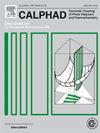利用高温质谱法对铀-硒体系的蒸发热力学和双相区进行研究
IF 1.9
3区 材料科学
Q4 CHEMISTRY, PHYSICAL
Calphad-computer Coupling of Phase Diagrams and Thermochemistry
Pub Date : 2024-09-24
DOI:10.1016/j.calphad.2024.102751
引用次数: 0
摘要
在 1148-1465 K 和 1222-1471 K 温度范围内,分别采用克努森喷射质谱法(KEMS)对 <U3Sn7(cr)+USn2(cr)>和 <USn2(cr)+USn(cr)>两相区进行了高温汽化热力学研究。在这两个双相区的平衡气相质谱中,Sn(g) 是唯一被观测到的物种。Sn(g) 的分压-温度关系推导为:log(pSn/Pa) = (-15,737 ± 73)/(T/K))+ (9.52 ± 0.06) (1148-1465 K) <U3Sn7(cr) + USn2(cr)> andlog(pSn/Pa) = (-16,151 ± 67)/(T/K))+ (9.70 ± 0.05) (1222-1471 K) <USn2(cr)+USn(cr)>利用 p-T 关系,用第二定律法评估了下列异相反应平衡焓:U3Sn7(cr) = 3USn2(cr) + Sn(g) 和 USn2(cr) = USn(cr) + Sn(g)。随后,得出了形成 U3Sn7(cr) 和 USn2(cr) 的吉布斯能。对这两个双相区域的努森流出质谱研究是首次报道。本文章由计算机程序翻译,如有差异,请以英文原文为准。
Vaporisation thermodynamic studies over and biphasic regions of U-Sn system using high temperature mass spectrometry
High-temperature vaporisation thermodynamic studies over <U3Sn7(cr) + USn2(cr)> and <USn2(cr) + USn(cr)> two-phase regions were carried out by employing Knudsen Effusion Mass Spectrometry (KEMS) in the temperature range 1148–1465 and 1222–1471 K, respectively. Sn(g) was the only species observed in the mass spectra of the equilibrium vapour phase over both the biphasic regions. The partial pressure-temperature relations of Sn(g) were deduced as
log(pSn/Pa) = (−15,737 ± 73)/(T/K)) + (9.52 ± 0.06) (1148–1465 K) <U3Sn7(cr) + USn2(cr)> and
log(pSn/Pa) = (−16,151 ± 67)/(T/K)) + (9.70 ± 0.05) (1222–1471 K) <USn2(cr) + USn(cr)>
Using p-T relations, the enthalpies of the following heterogeneous reaction equilibria were evaluated by the second law method: U3Sn7(cr) = 3USn2(cr) + Sn(g) and USn2(cr) = USn(cr) + Sn(g). Subsequently, the Gibbs energies of the formation of U3Sn7(cr) and USn2(cr) were derived. Knudsen effusion mass spectrometric studies over these two biphasic regions are being reported for the first time.
求助全文
通过发布文献求助,成功后即可免费获取论文全文。
去求助
来源期刊
CiteScore
4.00
自引率
16.70%
发文量
94
审稿时长
2.5 months
期刊介绍:
The design of industrial processes requires reliable thermodynamic data. CALPHAD (Computer Coupling of Phase Diagrams and Thermochemistry) aims to promote computational thermodynamics through development of models to represent thermodynamic properties for various phases which permit prediction of properties of multicomponent systems from those of binary and ternary subsystems, critical assessment of data and their incorporation into self-consistent databases, development of software to optimize and derive thermodynamic parameters and the development and use of databanks for calculations to improve understanding of various industrial and technological processes. This work is disseminated through the CALPHAD journal and its annual conference.

 求助内容:
求助内容: 应助结果提醒方式:
应助结果提醒方式:


